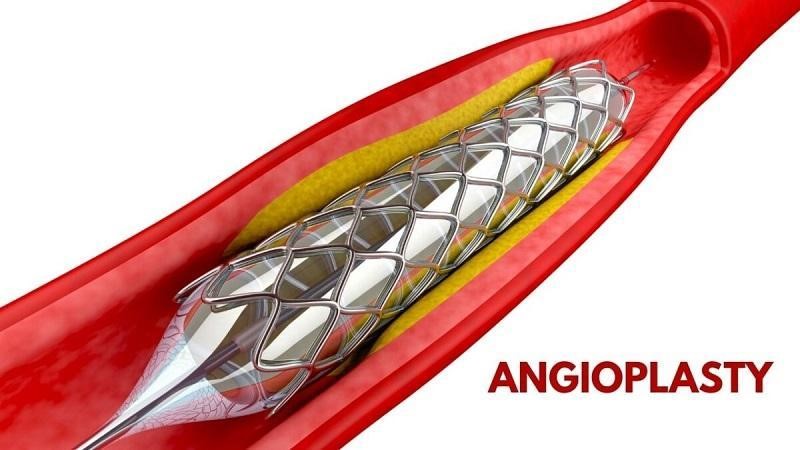Angioplasty is a medical procedure used to widen narrow or blocked blood vessels. This helps improve blood flow and can relieve symptoms of conditions like heart disease and peripheral artery disease (PAD). In some cases, a stent (a small metal mesh tube) may also be placed in the vessel to keep it open. Angioplasty is usually performed as a minimally invasive procedure, meaning it doesn’t require surgery. It’s often done using a catheter (a thin, flexible tube), which is inserted through a small incision in the skin.
Types of Angioplasty?
There are three types of angioplasty:
- Percutaneous transluminal coronary angioplasty (PTCA),
- Direct stenting
- Atherectomy
Percutaneous transluminal coronary angioplasty (PTCA) is the most common type of angioplasty. It involves the insertion of a balloon-tipped catheter into the blocked artery. The balloon is then inflated, which widens the artery and improves blood flow.
Direct stenting is a newer technique that involves the placement of a stent (a small metal mesh tube) into the blocked artery at the same time as the balloon is inflated.
Atherectomy is a less common type of angioplasty that involves the removal of the plaque from the blocked artery. This is done using a rotating cutting device or laser. Atherectomy can be used in cases where PTCA or direct stenting are not possible or have failed.
Also read sw418 live
Why is Angioplasty performed?
Angioplasty is a minimally invasive procedure used to treat narrowed or blocked arteries. The goal of the procedure is to improve blood flow and relieve symptoms such as chest pain and shortness of breath. Angioplasty is usually performed in an outpatient setting and doesn’t require general anesthesia.
During angioplasty, a small balloon is inserted into the artery and inflated.
In some cases, a small wire mesh tube called a stent may be placed in the artery to keep it open.
After the procedure, you’ll likely need to take medication to reduce your risk of developing blood clots. You may also need to make lifestyle changes, such as quitting smoking and eating a healthy diet, to reduce your risk of future problems.
Angioplasty is one treatment option for narrowing or blockages in the arteries. Surgery is another option. Your doctor will recommend the best treatment option for you based on your individual needs.
Who performs angioplasty?
Angioplasty is a minimally invasive procedure that is used to treat narrowed or blocked arteries. The procedure involves inflating a balloon inside the artery in order to widen it and improve blood flow. Angioplasty is typically performed by interventional cardiologists, vascular surgeons, or other specially trained physicians.
What happens during an angioplasty?
During an angioplasty, a small balloon is inserted into the artery and then inflated. Angioplasties can be done in a hospital setting or in an outpatient setting. Recovery times vary, but most people are able to go home the same day. There is usually some discomfort involved, but this can be managed with pain medication. Angioplasties are generally safe procedures with a low risk of complications.
After the procedure, it is important to follow your doctor’s instructions for care. This may include taking medications to help prevent clotting, monitoring your blood pressure, and eating a healthy diet. You should also avoid smoking, as this can further damage your arteries. With proper care, an angioplasty can help to improve your quality of life by improving blood flow and preventing heart disease.
What is the difference between stents and angioplasty?
There are two common procedures used to treat blocked arteries: angioplasty and stenting. Both procedures involve opening up the artery to improve blood flow.
Angioplasty is typically the first treatment option for blocked arteries. A balloon is inserted into the artery and inflated, which widens the artery and improves blood flow. In some cases, a wire mesh tube called a stent may be inserted into the artery to keep it open.
Stenting is often used when angioplasty fails to relieve symptoms or if the artery becomes blocked again soon after angioplasty. A stent is a metal mesh tube that is inserted into the artery to hold it open. Your doctor will discuss the best treatment option for you based on your individual situation.
Angioplasty patients are advised to take rest and stay away from any form of physical lovemaking for a few months. Males who have undergone angioplasty can boost their libido and enjoy fun filled mating session with the prescribed dose of Super Kamagra 160mg.
How is an angioplasty performed?
An angioplasty is a procedure that is used to widen a blocked or narrowed blood vessel. A small balloon is inserted into the blood vessel and then inflated. This helps to improve blood flow through the vessel. In some cases, a stent (a metal mesh tube) may also be placed in the vessel to keep it open.
The procedure usually takes around 30 minutes to an hour to complete. After the procedure, you will need to stay in hospital for a few hours so that your doctor can monitor your recovery.
You may experience some discomfort and bruising at the site of the angioplasty. You will usually be able to go home the same day or the day after the procedure.
Most people make a full recovery from angioplasty and can return to their normal activities within a few days. In some cases, further treatment may be required if the angioplasty does not successfully treat the blockage.
Risks and complications related to angioplasty
Angioplasty is a minimally invasive procedure used to treat narrow or blocked arteries. The risks and potential complications of angioplasty include:
- Bleeding
- Infection
- Arterial injury
- Blood clots
- Rest enosis (re-narrowing of the treated artery)
These risks and complications are rare, and most patients who undergo angioplasty experience little to no discomfort and make a full recovery. However, it is important to discuss all potential risks and complications with your doctor before undergoing any medical procedure.
How can you prepare for angioplasty?
Before you undergo angioplasty, your doctor will likely run some tests to check the severity of your condition and see if the procedure is right for you. They may also ask you to stop taking certain medications, such as blood thinners, a week or so before the procedure.
In the days leading up to angioplasty, you should:
- Eat heart-healthy foods
- Exercise regularly
- Quit smoking
Angioplasty is a relatively safe and common procedure, but as with any medical procedure, there are some risks involved. These may include:
- Allergic reaction to the Contrast Dye
- Infection
- Kidney damage from the contrast dye
- Nausea and vomiting
- Stroke
- Sudden heart attack
- Death (though this is very rare)
You should discuss all of the risks and benefits of angioplasty with your doctor before you undergo the procedure.
What can you expect after your angioplasty?
After you have angioplasty, you can expect to feel better. Your chest pain should go away and you should be able to move around more easily. You may still need to take medicine to prevent chest pain, but you will likely need less than you did before the procedure.
You will need to stay in the hospital for a few days so that your doctor can make sure the procedure were successful and that you are recovering well. Once you go home, you will need to take it easy for a week or two. You should not lift anything heavy or do any strenuous activity during this time.
After a few weeks, you can start to slowly increase your activity level. Your doctor will let you know when it is safe for you to start driving and returning to your normal activities.
Angioplasty patients must take adequate precaution prior to any physical intimacy
A male who has undergone angioplasty is advised to stay away from lovemaking for some time. Such males must get in touch with their primary health care physician, in case they want to indulge in any form of physical intimacy. If they want to buy Kamagra UK for improving their bedroom performance, they must get the prior approval of a certified general physician.
Read megapersonal for more interested information .

